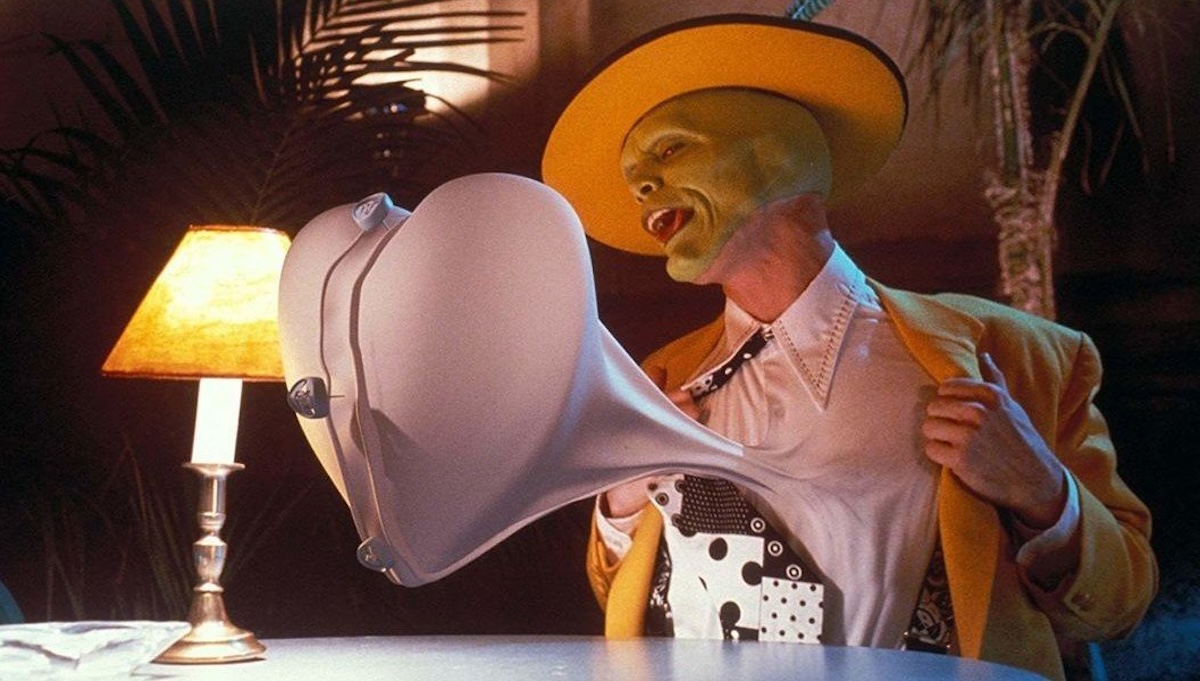
In the summer of 1994, no one could go for more than 15 minutes without hearing the words, “Oh! Somebody stop me!”
More than “Aaaaalll righty then!” or “I like it a lot!” that line from The Mask captured 1994: the year where Jim Carrey dominated the box office with three blockbuster comedies. In addition to The Mask in July, Ace Ventura: Pet Detective released in February, and Dumb and Dumber came out in December. But whereas Ace Ventura and Dumb and Dumber were a bit too raunchy for moms and uncles, the cartoon logic and zany big band music of The Mask made it a safe way for everyone to get Jim Carrey fever.
That’s a real surprise to anyone who knows The Mask comics by Mike Richardson, Mark Badger, Doug Mahnke, and John Arcudi. Those comics portray the story’s main character Big-Head as a violent sociopath, making Jim Carrey’s star-driven turn as nominally the same character a true product of its moment.
Big-Head Unmasked
As in the Jim Carrey movie, the first comic book miniseries The Mask from 1991 followed put-upon nerd Stanley Ipkiss, who became a living cartoon after discovering a magical green mask. And like the Jim Carrey movie, The Mask comics see Stanley applying cartoon logic to the real world. But in the comics, no one else really operates according to cartoon logic—the main exception being a huge, silent, and unkillable mob enforcer called Walter—which means that their bodies get twisted and mutilated in horrifying ways when facing the threat of an anvil or mallet.
During a revenge montage in the second issue of the first series, Stanley dons the Mask to become Big-Head and visits his former second-grade teacher. Seeing that teacher be strict, but not cruel, to a young student, Big-Head enters the classroom in order to mock and then beat up his former teacher in front of children. Later in that same issue, his girlfriend Kathy checks in on him only to find Stanley dressed in camo and barking out orders to her like a men’s rights activist.
Even when Big-Head decides to “clean up the city” later in that first miniseries, he chooses his victims less because of the threats they pose to others and more because they bullied him or made him feel inferior. Only a last-second moment of self-realization at the end of the first series gives Stanley the strength to remove the mask, putting Big Head behind him.
In each of the follow-up series, the mask bounces from user to user, including a quartet of nerds, a dutiful soldier, a mute little girl, and even Kathy herself. In each case, they transform into Big-Head, who then goes on to slaughter and threaten anyone they meet. The Looney Tunes quality of the chaos makes the violence feel more upsetting, not less.
So when Richardson and Todd Moyer, the vice president at Dark Horse Comics, brought the character to New Line Cinema, they intended a horror movie more in the vein of the comics.
“When I pitched the project, it was around the time of all those Nightmare on Elm Street sequels,” Richardson told the LA Times in 1994. “But I didn’t want this to be the next Freddy Krueger. I wanted the main character to be more like Tex Avery. The characters began to evolve, and Stanley Ipkiss became more of a repressed romantic.”
The main bit of evolution: Jim Carrey.
The Rise of the Rubberfaced Man
Strange as it seems now, Hollywood used to treat comic books as an embarrassment more than a valuable resource. Superman had Clark and Lois and Lex Luthor, sure, but it focused a lot of time on new creations Miss Tessmacher and Otis. 1989’s Batman plays more like a traditional action movie, in which Batman hunts down the man who killed his parents instead of fighting crime in general. The Red Skull, reimagined as an Italian soldier, who has a scarred but normal face in all but his first scenes in 1990’s Captain America. That’s more than Frank Castle gets in 1989’s The Punisher, in which Dolph Lundgren wears all black, with not even a death’s head logo.
In those days, IP commanded a bit of respect in some cases—Batman had to be Bruce Wayne, for example, even if Catwoman could be Patience Philips—but not as much as studios and stars. So when Carrey signed on to The Mask, it wasn’t a hard decision to refit the movie around him instead of asking the actor to transform himself for the part.
To be clear, the movie’s changes in tone happened before Carrey had his big breakout with Ace Ventura. Early scripts were done as soon as 1991, and the producers considered performers ranging from Rick Moranis to Martin Short as Ipkiss. But when New Line Cinema president Michael De Luca saw Carrey on In Living Color, he suggested the Canadian comedian to director Chuck Russell, who loved the idea and ordered the script rewritten to suit Carrey.
Although Russell had “Nicolas Cage and Matthew Broderick” initially in mind for Stanley, he admits that “really, we wrote it for Jim Carrey.” In fact, Russell claims that when Carrey first read the script, the actor was thrilled at how well it suited him, something that couldn’t be said of the unrevised story.
These revisions stripped away any remains of Big-Head’s menace that might have lingered from the comics. Even Ipkiss gets changed from an embittered peon to a put-upon romantic who just lacks the confidence to show off his true nature. Thus when the Ipkiss of the movie puts on the Mask (he’s not called Big-Head in the film), he gets that confidence and becomes the funny and compelling person he’s always been—albeit in a more obnoxious form. Big-Head was gone. The Mask is all that remained.
Lifting the Mask
Three decades later, it’s hard to say that New Line made a mistake. The Mask movie was a huge hit and spawned an animated series as well as a more kid-friendly cartoon. The initial enthusiasm has died down, especially after the unwatchable Jamie Kennedy vehicle Son of the Mask (2005), but the movie still garners more admiration than the comics, which remain cult objects.
Still, in these days where not even Harrison Ford can escape becoming the Red Hulk if it happened in the comics, The Mask is a fascinating time capsule to a lost era in Hollywood. These days, adherence to comic book canon rules all, but back then no one could stop movie stars on the rise like Jim Carrey.
The post Jim Carrey’s Version of The Mask Could Only Happen in the ‘90s appeared first on Den of Geek.






